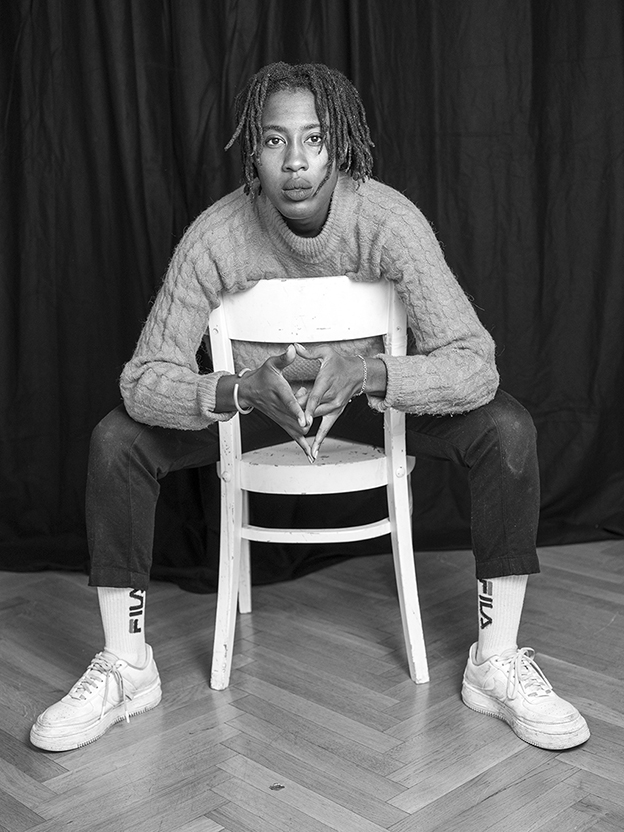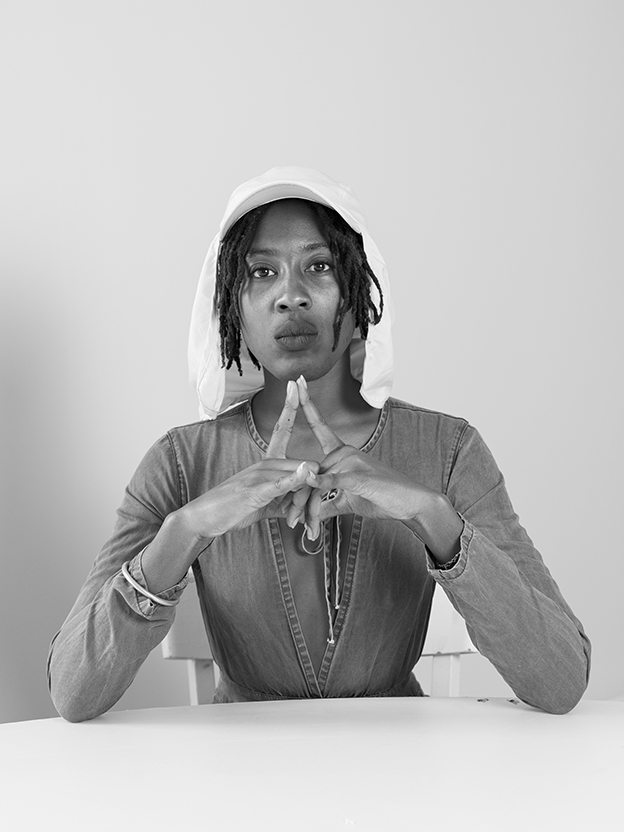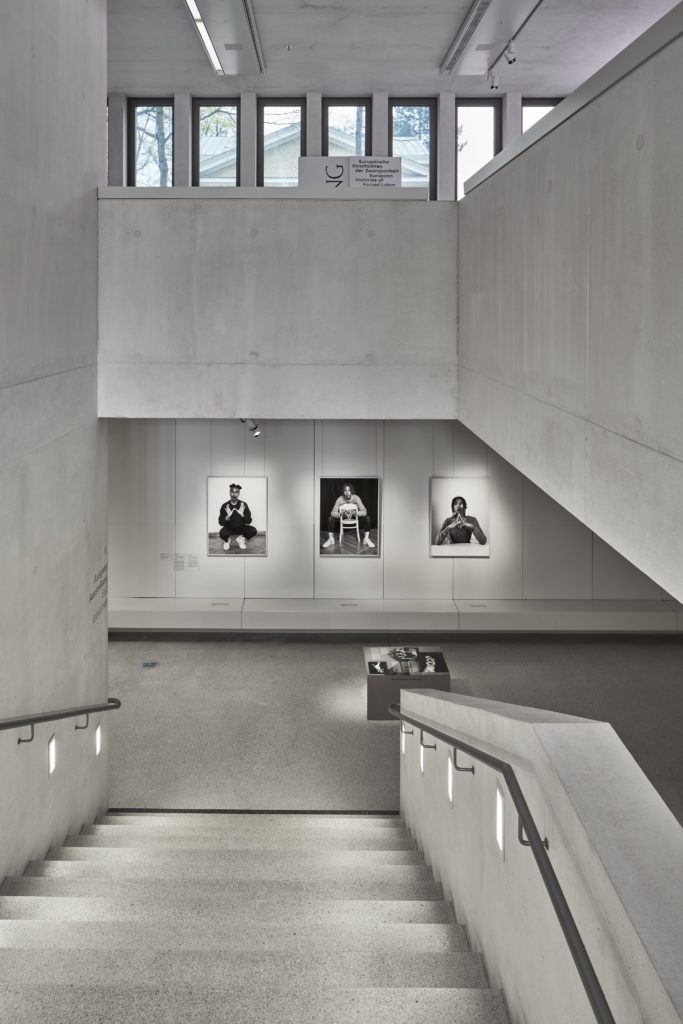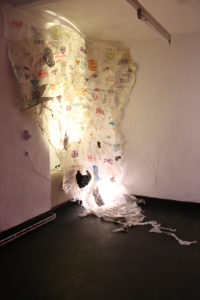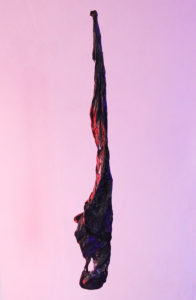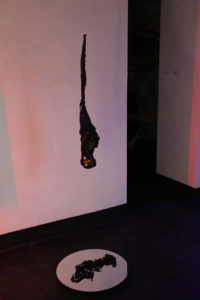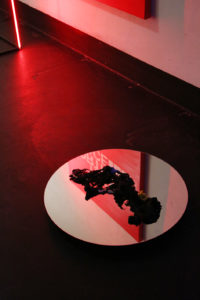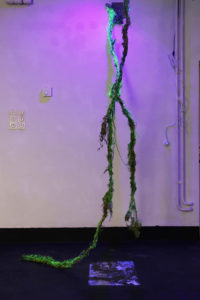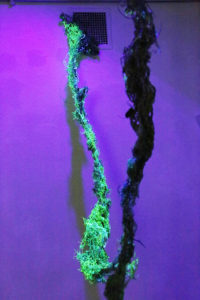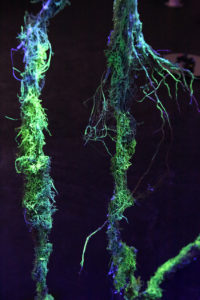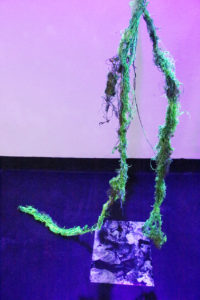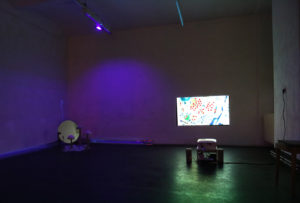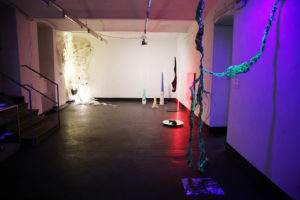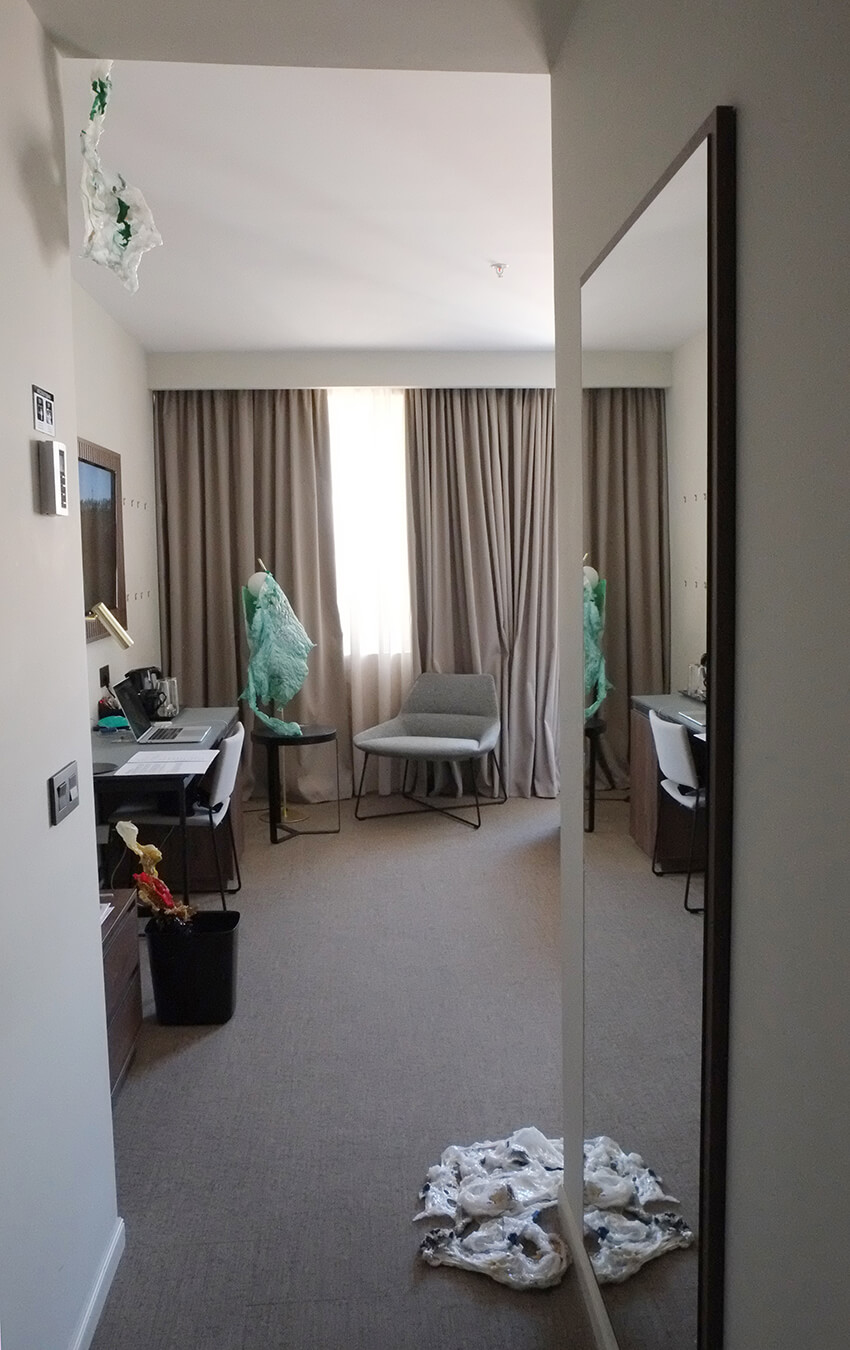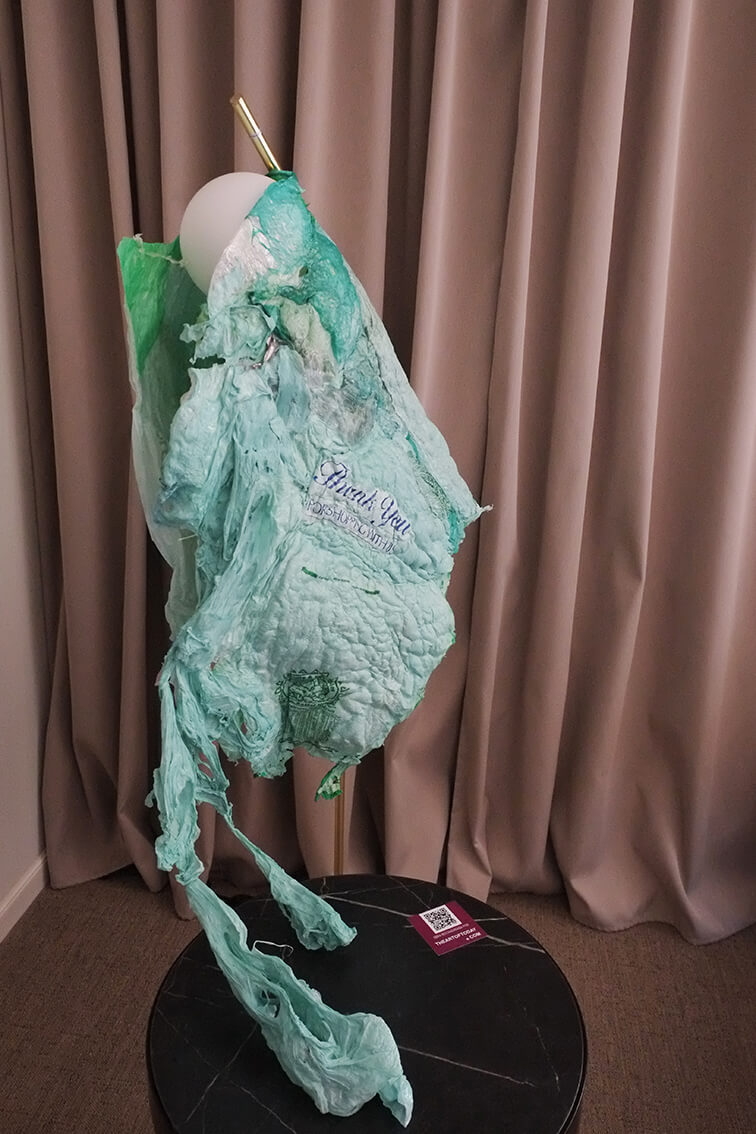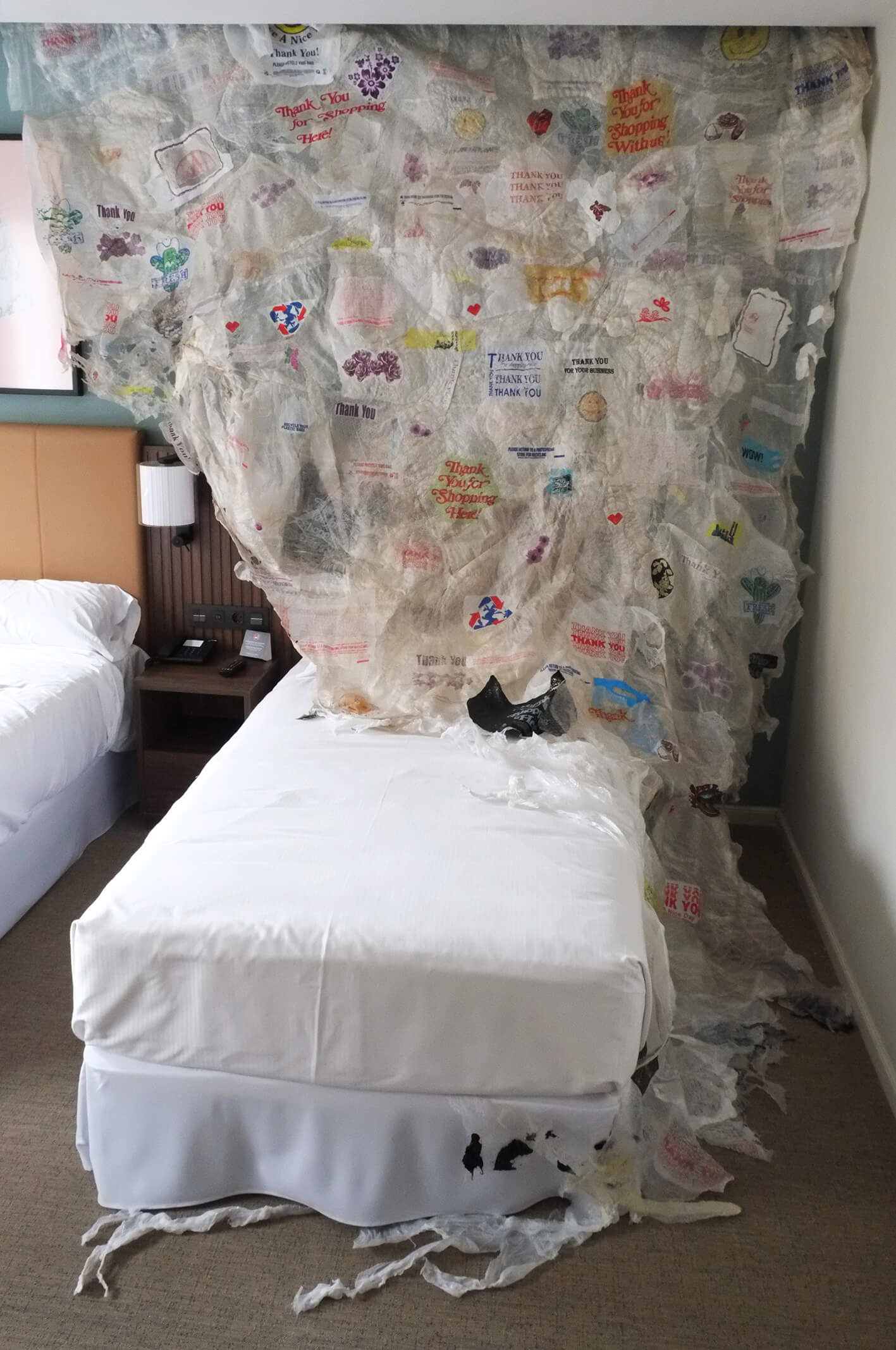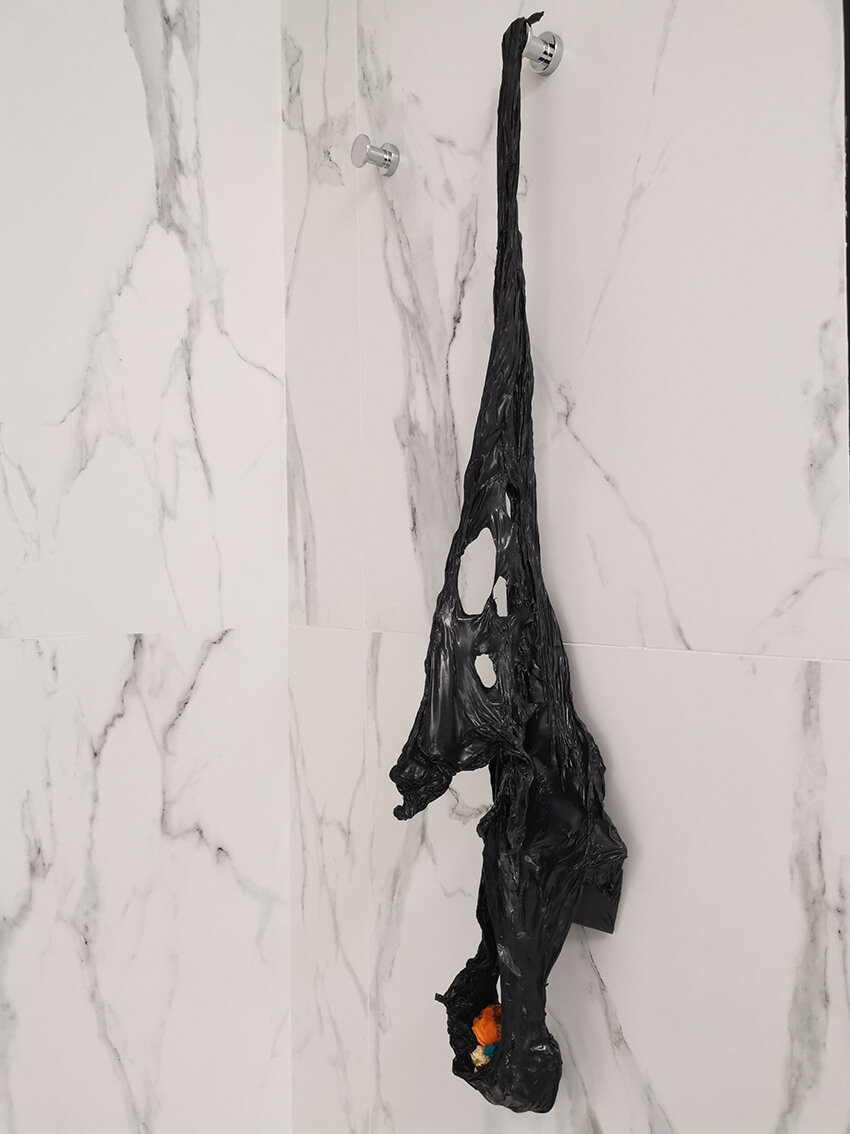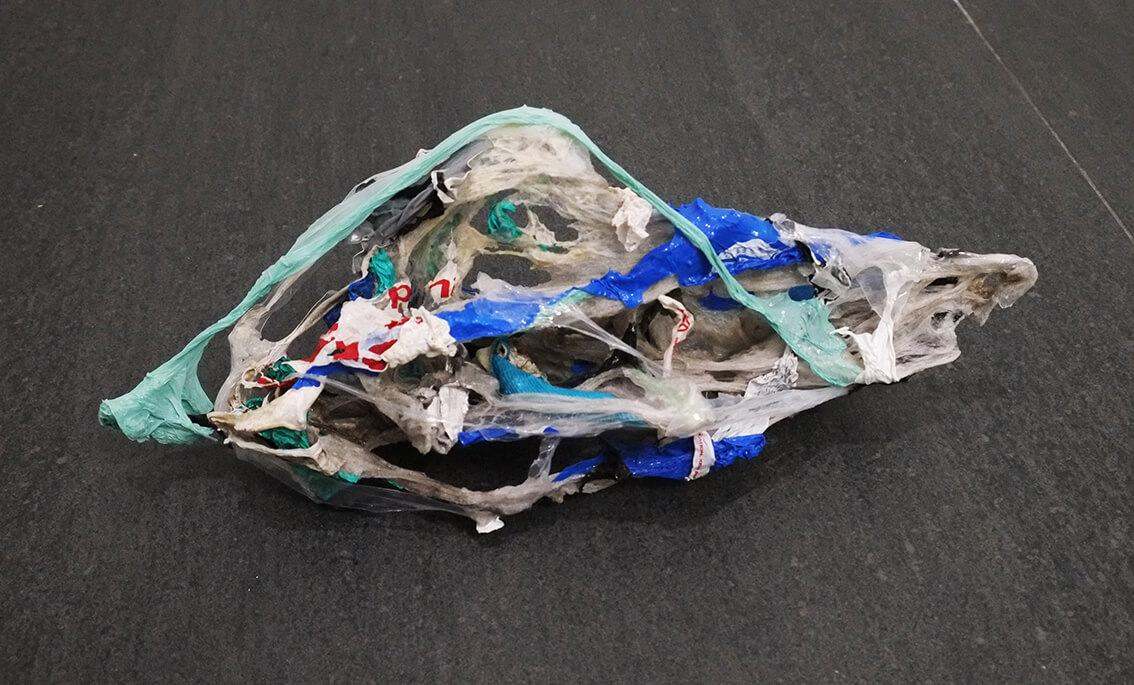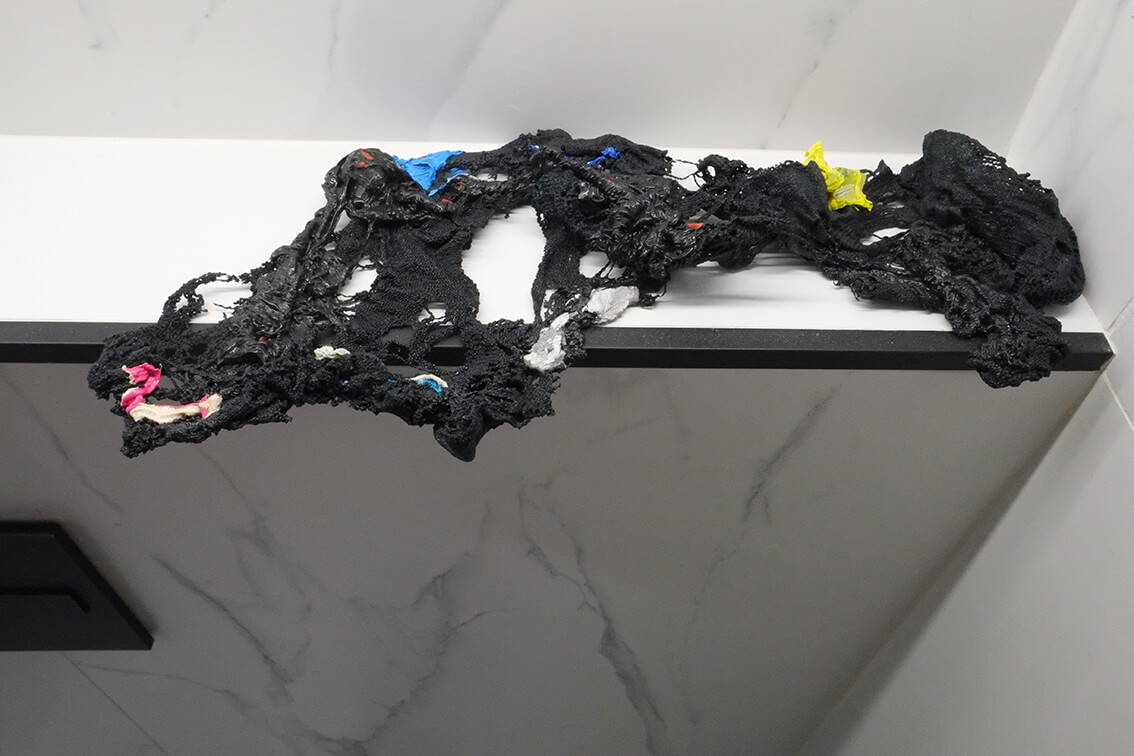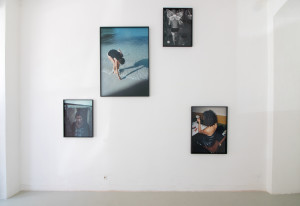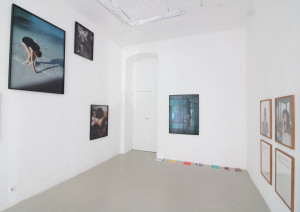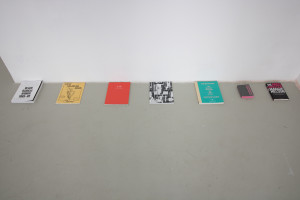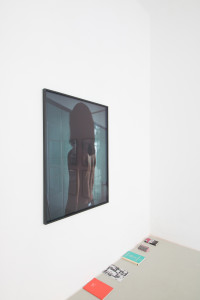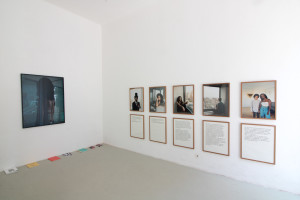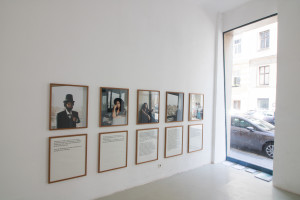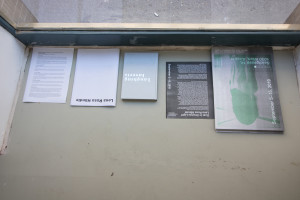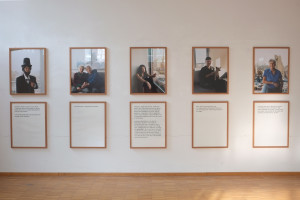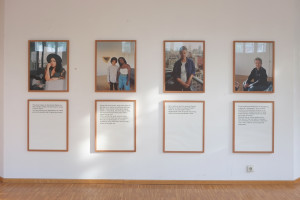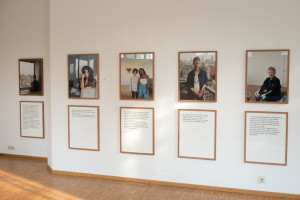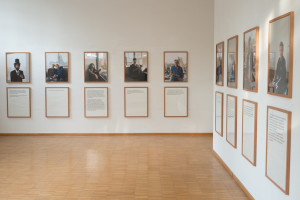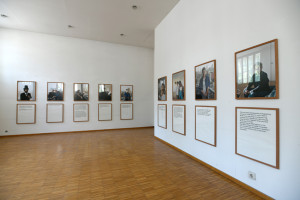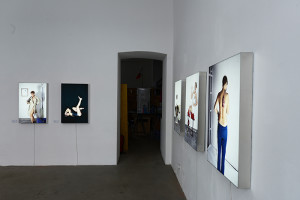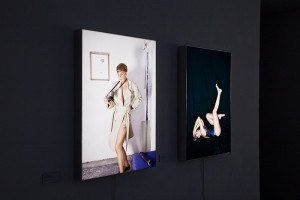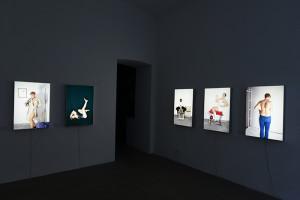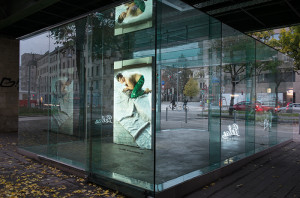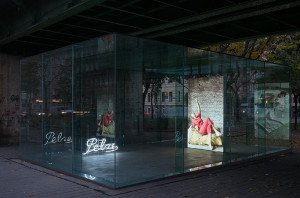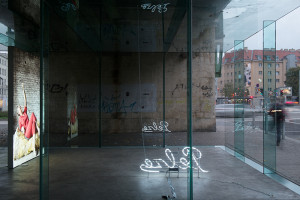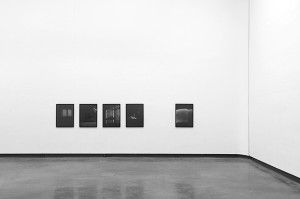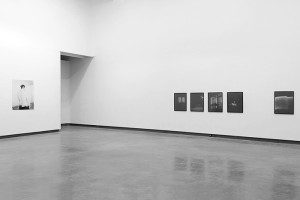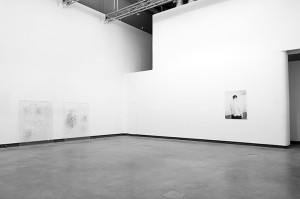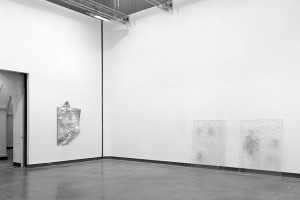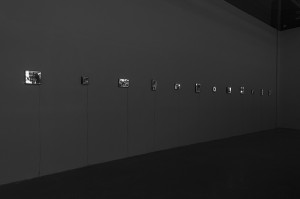selected exhibitions
These Hands – An Inimitable World
3 Inkjet Photographs framed, 70 x 100 cm, 1 Off-Set Print Poster (engl./german), Edition 500, 59, 4 x 84,1 cm, 2022
Commission work for the exhibition TO BE SEEN. Queer Lives 1900-50, 07.10.2022–21.05. 2023 at NS-Documentation Center, Munich
Installation Photos: Orla Connolly
The work explores the continuity of veiled lesbian codes from the 1920s to the present day. With reference to the dancer Tilly Losch, the painter Mariette Lydis, and the artist Claude Cahun she focuses on the motif of hands as lesbian gesture and code. Together with the influencer, DJ and cultural producer Tonica Hunter she reinterprets these historical gestures in her photographs, also recalling the first female-run photo studios of the 1920s. On the poster her own photographs enter into a dialogue with the historical material, offering the viewer an opportunity to transport these gestures into public and private spaces.
Girls under Trees
digital print on acrylic fabric, embroidery, 220 x 126 cm, 2016
Exhibition TO BE SEEN. Queer Lives 1900-50, 07.10.2022–21.05. 2023 at NS-Documentation Center, Munich
Foto: Orla Conolly
For her work Mädchen unter Bäumen (Girls under Trees), Lena Rosa Händle uses the motif of a tapestry that schoolgirls embroidered in 1941 in painstaking collaborative work during the handicrafts classes that were compulsory for girls at that time. Händle adds two classified ads from the 1942 Vienna Wochenschau to the motif: “Young woman look ing for correspondence with female friend un-der modern” and “Lady seeks female friend for movies and theater.” Advertisements like these are evidence of the few coded signs of lesbian sub-culture during the Nazi era. Terms like “Fräulein (young woman),” “Freundin (female friend),” and “Dame (lady)” served as lesbian identification codes, as did the colors purple and violet. By juxta-posing the embroidered quotation on the tapestry with the coded meanings of the terms used in the newspaper advertisements, the artist subtly refers to themes such as political power structures, socially enforced expectations, and the resulting nuances of lesbian aesthetics.
___________________________________________________________________________________________________________
From hunderts of roots, which drink silently
Exhibition 04. 03. – 19.03. 2023 with David Meran, basement Vienna, 2023
(texts in german- english texts coming soon)
Mit dem literarischen Titel aus Rainer Maria Rilke Stundenbuch (1918) eröffnen Lena Rosa Händle und David Meran ihren künstlerischen Dialog. Damit wird der Gedanke der Form als Erhaltungs- und Entfaltungsraum künstlerisch-religiöser Inspiration verbunden.
Die Transzendenz der Dinge findet sich bei Rilke in Wurzeln, Blumen, oder beim Durchscheinen einer blauen Hortensie. Wie steht es um unsere Biodiversität in unseren Böden, wo befindet sich überall Mikroplastik und können wir Krisen künstlerisches abbilden?
Die Ausstellung zeigt zwei auf den ersten Blick unterschiedliche Positionen, doch ergänzen und
komplettieren sich die Arbeiten von Lena Rosa Händle und David Meran in ihrer materiellen
Beschaffenheit. Viele der gezeigten Arbeiten liegt der ursprüngliche Rohstoff Erdöl zugrunde damit verweisen sie auf klimapolitische Fragestellungen.
please click into the image to entlarge
redigierte Eröffnungsrede von Hartwig Knack
(text in german- english text coming soon)
Lena Rosa Händles große Arbeit „Thank you for shopping with us!“ schlägt in eine ähnliche Kerbe. Während einer residency in New York sammelte sie Plastiksackerl und hat eine Art Kunststoffteppich daraus collagiert. Der Künstlerin geht es dabei um das Material Plastik und um den Umgang mit Müll. Aber auch um die Materialiät dieser Plastiksackerl, die sich – von hinten beleuchtet – als milchig-transparent zeigen und ein diffus Dahinterliegendes erkennen lassen. Das Ganze erinnert in gewisser Weise an die Funktion einer Membran, die aufgrund ihrer Eigenschaften Trennschichten einerseits, Bereiche des Übergangs von Davor und Dahinter, von Durchlässig und Undurchlässig andererseits beschreibt.
Händle hat hier die Assoziation „menschliche Haut“ als Schutzmantel ins Spiel gebracht. Das erscheint insofern sehr passend und spannend, weil Plastik ja wie unsere Haut auch als Schutz vor Verschmutzung und Beschädigung dient. Gemüse, Obst oder auch industriell hergestellte Waren werden mit Plastik verpackt und geschützt. Kunstwerke werden ebenfalls in z.B. Luftpolsterfolie verpackt, bevor sie transportiert werden usw. Wenn wir uns die Dimensionen des Plastikmülls weltweit vor Augen halten, entpuppen sich diese vermeintlich schützenden Folien und Verpackungen zunehmend als eine global sich ausbreitende Hülle, die alles zu ersticken, alles zu zerstören droht. Mikroplastik überall: In den Meeren, in den Fischen, in den Lebensmitteln, in uns: Durch den Schutzmantel unserer Haut, durch die Lunge aufgenommen, Tiere, die jämmerlich zugrunde gehen, wenn sie Plastikmüll verschlucken. Von Tag zu Tag wird es schlimmer … Die große Arbeit von Händle scheint diese Situation in gewisser Weise zu spiegeln – sie scheint tatsächlich noch expandieren zu wollen. Wie mit Tentakeln ausgestattet, scheint sich das teilweise durch Wärmezufuhr geschmolzene Plastik weiter in den Raum ausdehnen und vorarbeiten zu wollen.
Die von der Decke bzw. von der Wand abgehängte Arbeit Mycorriza, 2023 Händles ist aus tatsächlichen Wurzeln gefertigt, die die Künstlerin im Wald gefunden hat. Mit Farbe, Klebstoff und Licht setzt sie ihre Arbeit in Szene. Im Gespräch führt Händle aus, dass 90% aller Pflanzen ohne Pilze nicht überleben können. So erkläre sich auch der Titel der Arbeit: „Mykorrhiza“. Als Mykorrhiza werde eine Form der Symbiose von Pilzen und Pflanzen bezeichnet, bei der ein Pilz mit dem Wurzelsystem einer Pflanze in Kontakt stehe.
Grundsätzlich spielt in Händles Arbeit das Thema „Symbiosen in der Natur“ immer wieder eine Rolle. Interessant in diesem Kontext scheint der Gedanke, dass entgegen der Evolutionstheorie Darwins, dem gemäß sich die stärkeren, am besten angepassten Lebewesen gegenüber den weniger starken durchsetzen und überleben, hier in einer Symbiose, in einer Gemeinschaft, durch ein konstruktives Zusammenarbeiten das Überleben erst gesichert ist.
Die Arbeit dort hinten am Boden ist – und das passt thematisch ganz gut hierhin –eine spontan entstandene temporäre Gemeinschaftsarbeit von Lena Rosa Händle und David Meran. Die aus Gips und Beton bestehenden Pilze stammen von Meran, die geschmolzenen Plastikobjekte von Händle: Das Symbiotische, das Netzwerk aus Wurzeln und Pilzen findet sich in dieser Arbeit als Geflecht aus Kooperation und Interaktion wieder. Inhaltlich gesehen, erscheint diese Arbeit eine absolut toxische: Die Pilze wachsen nicht aus einem gesunden Waldboden, sondern aus einer Oberfläche aus Plastik. Da sind wir wieder beim Themenspektrum „Mikroplastik“, das sich nicht nur im Wasser und in Nahrungsmitteln, hingegen auch in den Böden ablagert. Beugt man sich ganz nahe zu den Pilzen hinunter, dann steigt uns der Geruch alten Motoröls in die Nase. Die von Rilke poetisch und romantisierend beschworenen schöpferischen Kräfte der Natur sind hier auf jeden Fall mit Vorsicht zu genießen. Das ganze Szenario ist in ein sphärisches Schwarzlicht getaucht. Mystisch, geheimnisvoll. Die Romantiker hätten dieses Licht vermutlich geliebt …
Die filmische Collage Lena Rosa Händles, entstanden 2020 im ersten Lockdown, zeigt sich als eine Art Summary der Ausstellung: Eine Auseinandersetzung mit politischen und Umweltfragen, mit der Klimakrise und dem Coronavirus. Eine Verknüpfung verschiedener persönlicher Assoziationen macht den Film aus: Landschaften, Fotos, Pressartikel, Materialien aus dem Archiv der Künstlerin und vieles mehr. Der Film heißt: „Das kommt von innen“. In der Übersetzung etwa: Das alles geht von und aus. Das alles ist Menschengemacht.
___________________________________________________________________________________________________________
Thank you for Shopping
with Us!
Plastic sculptures, different dimensions, 2021
Solo exhibition Hybrid Art Fair, RIU Hotel, Madrid, May 2021
In cooperation with das weisse haus & Austria Cultural Forum, Madrid
text Frederike Sperling, (das weisse haus)
With her variously-sized sculptures, Lena Rosa Händle zooms into the complex dependencies between plastic and turbocapitalism, ultimately raising urgent questions around the affects and consequences of toxic waste for nature and its diverse ecosystems.
Multiple plastic objects are hanging or laying throughout the space. Like tentacular organisms, they gradually infiltrate the room – morphing out of the Riu Hotel’s hidden cracks and crevices. What or who are they and what are they up to? Will they do harm? Oscillating between states of living and non-living, these creatures evade any deterministic fixation. Instead, they mutate and fluctuate, seemingly ready to change rhythms and directions in no time. Their skin, though rough, is ready to bend and twist into immediate action.
The versatility and animate features of Lena Rosa Händle’s sculptures are reminiscent of the very material characteristics of plastic. Durable and hardly degradable, plastic is inside all of us and everywhere. In the course of the sixty years of plastic mass production, 8.3 billion tonnes have been produced – out of which merely 9% haven been recycled. Plastic pollution – especially in the form of microplastics – is a direct threat to wildlife habitats: In the Pacific Ocean alone, three million tons of plastic are floating between California and Hawaii with the size of Central Europe. Unsurprisingly, there are six times more items of plastic debris than plankton in that area.
Lena Rosa Händle transforms the uncanny truths about our relationship to a toxic material into an immersive spatial intervention. She makes us understand that plastic, a key component for global capitalism, will not go, it will only become more and ultimately take over.
… Thank You For Shopping With Us!
___________________________________________________________________________________________________________
DUST IN STRANGE LIGHT
A selection of photographs of the works Laughing Inverts, Places of Passing and I (We) Feel Seen, LLLLLL Space for Contemporary Art Vienna, 2019
curated, text and artist talk by John Kenneth Paranada
What is an important image in the age of digital consciousness? How do we filter them out? And ultimately, how do we derive meaning from the stages, frames and displays through which the contemporary image appears?
This exhibition is about things seen and unseen and the presence of absence. Lena Rosa Händle shines a light on the historically erased and forgotten images of abjected queerness. Digging through her photographic archives, Händle unearths past images that she has never shown before, juxtaposing them with her ongoing series “I (We) Feel Seen” 2018, “Places of Passing” 2013 and “Laughing Inverts” 2016 – and through this process weaving a cacophony of the diverse complexity of queerness and the politics of colour. Surveying the past years of Händle’s work, this conscious retrospective traces several significant strands of the artists‘ practice. Händle inventively explores the ways in which colonialism and patriarchy continue to shape how Western societies refuse to hear, see and feel the plight of queer-feminist, trans and gender non-binary persons in her works. Over the last ten years, Händle has developed a dynamic and thought-provoking inquiry into the notion of capturing queer solidarities. At its heart, lies a passionate critique of modern Western systems of control and organisation and the growing power of right-wing populism around the globe.
Händle’s photographic eye is unmistakable: the archive of her highly disarming, beautifully shot images are a haystack of revelations – each shot a little different but disciplined in their similarity. The photographs summons intense and consistent moods that evoke as if the images appear to be hypnotised by spirit; it is energetic and intriguing to the point where it’s like seeing the forest in its entirety and also seeing the trees all at once.
This exhibition addresses some of the crucial concerns of our time; normalised micro-aggressions, intersectionality, trans-rights, queer activism and love. It looks to engage the audience through our shared capacities for thinking and feeling. Through her sensitive approach, Händle invites us to approach her subject matter with a thoughtful examination and critical insight.
This complex and layered selection of her archive is testament to the ingenuity of her photographic eye and honest treatment of her subject, bringing to the fore how filtering important images is only possible through a dialogue of representation, subtlety, and abstraction; emancipating the frozen image of patriarchal social construction and revealing the ability of art to capture the monsters that dwell in the contemporary. Every important image must be made real – not merely exposed and shed light, to close the border, but as a reality of crossing, of recognising and witnessing the Dust In Strange Light.
___________________________________________________________________________________________________________
I (We) Feel Seen
9-C Prints, 11 Inkjet Prints, 65 x 70 cm, Text, Soho in Ottakring, Vienna 2018
artist talk with Georgia Holz
In the current political climate in which cis-male camaraderie is gaining power, this installation explores the in/visibility and diversity of queer-feminist artists. The analog portrait photographs are testimonies of dialog-based encounters at Lena Rosa Händle’s Residency Studio in New York. How do the encounters and connections between Lena Rosa Händle and the protagonists become visible?
Taking time, seeing, listening and engaging with are the starting points of this series, which subsequently produces connection, a process of learning, appreciation and (temporary) community.
A text by the protagonist about their picture hangs, equally framed under each portrait. An additional text by Lena Rosa Händle shares observations, feelings and comments on the encounters.
Through these two layers of text, views are expanded, levels of social inequality made visible, as well as questions asked about the portrait itself.
Thank you Ursula Knoll, Georgia Holz, Katharina Aigner and Marina Lewandowska as well as the Federal Chancellary of Austria (Residency, New York City), SOHO Ottakring and Cyberlab (Sponsoring: prints of the texts, laminations).
___________________________________________________________________________________________________________
Lena Rosa Händle & Katharina Aigner
Reclaiming Gestures 2, T/abor, Vienna 2017
text and artist talk by Juliane Bischoff
Lena Rosa Händle’s five light boxes are part of her series Reclaiming Gestures 2, where she negotiates depictions of the female body. The five photographs show the artist in different poses with props that cannot be clearly identified. The titles are Grosse Fotografen und Olympus (Great Photographers and Olympus), Verführerisch, unser neuer Bodenbelag…Das sinnliche Erlebnis auf Parkett (Seductive, our new flooring…the sensual experience on parquet), Filter Rillos (Filter Rillos), Macht Spass im Mund! (Fun in your mouth!), and Jungs kommt Grillen! (Boys come to grill!). The high-quality carbon prints in light boxes can be interpreted as advertisements. The composition and slogan-like titles draw on advertising images, although they contradict the usual advertising aesthetic. A break occurs between the written message and the image. The artist occupies the picture in a self-determined pose. Instead of advertised products, improvised seating made of metal frames and wooden palettes, a hasty drawing on paper, and the studio space become props in the picture. (…)
__________________________________________________________________________________________________________
Reclaiming Gestures 1
Kubus EXPORT – der transparente Raum, Vienna 2015
text by Doris Guth (Academy of Fine Arts, Vienna)
Lena Rosa Händle’s exhibition, Reclaiming Gestures (10.9. – 21.10.2015) in Kubus EXPORT—der Transparente Raum in Vienna represents a successful intervention to interrupt viewing habits in public space. A two-sided, larger-than-life light box is set in the glass cube under one of Vienna’s subway arches and shows two photographs. Next to it, a sculpture of the word Pelze (furs) appears in smaller neon writing on the floor.
The photos show the artist in two different poses: In Zu schön um wahr zu sein (Too beautiful to be true), she sits relaxed in red coveralls on furry, felt-like fabric and looks up at her hand reaching heavenward with a laugh. Whereas in Wenn’s lustig war, wenn’s lustig wird (When it was fun, when it gets fun), she crouches on a fuzzy wool blanket on the floor, her upper body is naked, and she is looking up at the viewer guardedly.
Both photos resemble advertising designs, while at the same time it is clear that this is not what they are. The presentation of the body, the clothing (work clothes, slippers), the surroundings (tattered, felted insulating material) do not conform to common advertising esthetics. The captured poses and gestures act as quotes, without their references being known. There are two specific advertisements being referred to. One is from the garden tool company Al-ko with the slogan Zu schön um wahr zu sein, the other is from MM champagne: Wenn’s lustig war, wenn’s lustig wird from the late 1960s. Both examples illustrate the sexist display of female bodies, where the woman, naked or partially naked, is reduced to her body and to “being beautiful.” In Zu schön um wahr zu sein, the woman in the ad is equated with the product—a lawnmower (!). In Wenn’s lustig war, wenn’s lustig wird, the woman lying in bed obviously becomes sexually submissive with the champagne. But the fun seems to apply more to the absent man, since the woman, curled up on the bed and shot from above, appears tired, small, and even helpless and is presented as a sexualized object. In any case, she is not a woman satisfied by orgasms, blissful, powerful, passionate, spreading her body across the bed.
The artist reappropriates the coopted and stereotyped gestures from the ads in her photographs by repeating the poses and making shifts. The focus is on an affirmative completion of the poses and a transformative new connotation. In Lena Rosa Händle’s works, the figures are transformed and queered: In one, we have the self confident woman dressed in bright red coveralls who smiles at her own body, and in the other, a woman in dirty work clothes crouching watchfully on the floor, looking directly at the viewer.
Judith Butler points out that body and gender are produced through performative repetitions. This is not only about restrictive technologies of power, but also creation and production. This process enables the undermining of discursive normalizations of gender identity and opens up moments of political freedom of action. In this quote-like and rearticulating practice, the poses and gestures in Händle’s photos offer a space of opposition and shifting. Innovative images are created that defy traditional habits of seeing and, at the same time, blend into urban space filled with advertising images. The photographs and their reflections light up and melt away in the night with the lights and images of the city, the transparent glass cube—which makes a separation between indoors and outdoors impossible, and dissolve in the fleeting motion of the passing cars.
The interpretation of the photos is reinforced and expanded through a sculptural element in the exhibit: The written word Pelze, which resembles a company name, repeats the reference to the consumer world while opening up another point of reference: Pelze-multimedia, a space for women and lesbians (FrauenLesben Raum) in Berlin from 1980 to 1994, which was located in a former fur shop. The original typography was translated into neon and pays homage to this special place.
from „Sei bereit für die Veränderungen des Universums, Werbungen und Sexismen“, Doris Guth, Hrsg. Frauen. Wissen. Wien. Nr. 4. MA57, 2015
___________________________________________________________________________________________________________
Spaces of Relations
Gallery of the Academy of Visual Arts, Leipzig, 2013
Haut ab! text by Stefanie Seibold
In Space of Relations, the artist Lena Rosa Händle brings together four disparate groups of works comprised of different techniques and/or motifs. Among them are two types of portraits, photographic and collage, a series of photographs with interior and urban spaces, as well as a glass sculpture and abstract material collages. How are these works connected, what kind of a Space of Relations is meant? Outer space, as the bright silver in one of the two collages seems to suggest? Or more of an inner view, an inner space, a feeling, an (secret) awareness, an invisible place? Lena Rosa Händle’s interest mostly likely lies in this second type of “space,” the kind that cannot be depicted easily and directly—spaces that are thought, felt, and experienced. Here she also looks at the very fundamental question of the significance of visibility for this complex project.
Silverfuture, destroyed. Dark rooms. Invisible. Alone. Averted. In darkness. Protected.
All of the works gathered here noticeably address their own planar surface. They are reflective or obscured, darkened, scratched, glued or torn and then made smooth. One can, therefore, assume that Lena Rosa Händle has also closely considered the surface reflections that constitute the photographic image—but they were defined as secondary here. (1) That the persistent idea that photography has a sort of genuine, indexical relationship to a depicted reality is aggressively disputed and deconstructed piece by piece. And this is precisely where Händle’s project comes in: challenging the significance of the visible in photographic work, the often too smooth surfaces of representation. The central theme is that which is and remains invisible and has to stay that way. Not as a primarily esthetic problem, but rather throughout Space of Relations as a parallel to the experience of total invisibility or the rendered invisibility of queer/trans/lesbian realities and structures of desire within the heteronormative regime of images surrounding them. (2)
I´ve got you under my skin* (3)
A key to this reading lies—along with the question of visibility—in the project’s present and absent bodies (also those of the viewers), particularly when dealing with portraits and body image.
In the series Place of Passing we only see the portrayed in a three-quarter, rear view; the faces are unrecognizable, the space around them remains undefined. In the averted face, upon which just a few details remain, such as a beard, the subjects deny the viewer a clear definition. With respect to themselves but also—and especially—with respect to gender. The denial of clear gender readability is a key queer issue, because the assumption of a dichotomous, organized gender system is based on heteronormative mechanisms of exclusion.
Transgender discourses also analytically challenge the two-gender system and practically defy it—like here—with diverging, self-determined concepts of identity. Both the title Places of Passing and the ambiguous physiognomy of the pictured bodies refer to a queer or transgender context.
The series Monsters follows the same logic. These small collage portraits pieced together from tabloid magazines can be understood here as queer dystopias, which reveal the smoothed, heteronormative sexist identities in the media as dystopian monsters that surround, threaten, and format us ubiquitously every day.
In the photographs in the series Of Other Spaces , the (queer) bodies are missing, but we almost suspect them to be hidden—beside what little is visible in the pictures—in the abundant (photographic) black. The absence of these bodies gives the works their meaning. In any case, the depicted places are only identifiable for insiders who know the exact codes to decipher them. Perhaps it is also best to keep these queer places secret, as they appear here—as our little secrets, places you will never know.
The photographs in the series Of Other Spaces and the sculptures in the exhibit work with a field of tension that is also important for queer theory and practice, between private and public space, again visible and invisible, obscured, hidden, coded and opaque, the visible surface and what is beneath or behind it. That which is possible in private space is far from possible on the street, before the law, or within the family.
The abstract collage/décollage pieces deal with (material) formations transferred from public space, which have a largely overlooked esthetic value there and only gain attention and significance when they are transferred to the art space. This process can again be seen as a parallel to the social marginalization of queer esthetics and ways of life, which are also only visible and of value in certain places and contexts. The two paper formations look like sediments of posters torn off the wall that multiply for years in a forgotten passageway and cover floods of advertising slogans and images layer by layer. One object was re-treated by the artist with paint, so that the layered information moves into the background and the unified, multilayered bodies that developed from them emerge as object entities. The architectural glass sculpture to which the remains of scratched off layers of paper are glued is perhaps what most clearly embodies the thematic and formal traces of surface, transparency, and (un)readability that Händle explores in her project. For a bright Silverfuture on the gummed up layers of the past.
1 This stands in contrast to her previous book, Laughing Inverts, which, in the tradition of Nan Goldin’s diary, emphasizes the visibility of queer deviance as a political necessity.
2 Like other systems of representation in the Western World, as noted by the literary critic Terry Castle: „(one is)…dismayed yet again at how invisible, literally and figuratively, lesbianism remains, even in the great rainbow-flag-waving cities of the West. Some of the smartest, most well-meaning straight people still don´t get it – in fact don´t even see it. This mole-blindness is all the more bizarre given the unremittingly vulgar sexual explicitness that otherwise assaults us everywhere in the mass media, not least in the cartoon world of online pornography.“ Terry Castle, You better not tell me you forgot , London Review of Books, Vol. 34 No. 18 · 27 September 2012, pages 3-11.
3 Passing in queer jargon is defined as: Being able to be seen in public as a member of one’s preferred gender, with no ambiguity or skepticism on the part of the viewer. Patrick Califia: Tranny Talk. A Glossary of Transgender Terminology, 2004. P. 4
3* Song title by Cole Porter, one of the most important song writers of the 20th century, who held luxurious queer parties in Paris as part of the Lost Generation.

